The Central Dogma of Molecular Biology
Objective 6.2
6.2.1 State the Central Dogma of Molecular Biology.
6.2.2 Define transcription, reverse transcription, and translation.
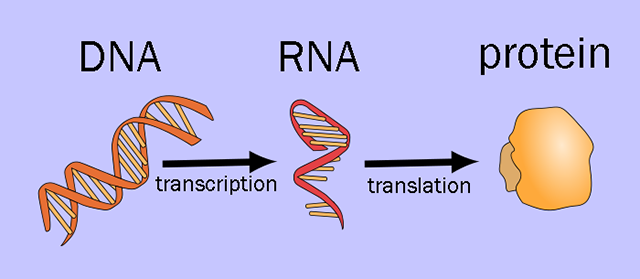
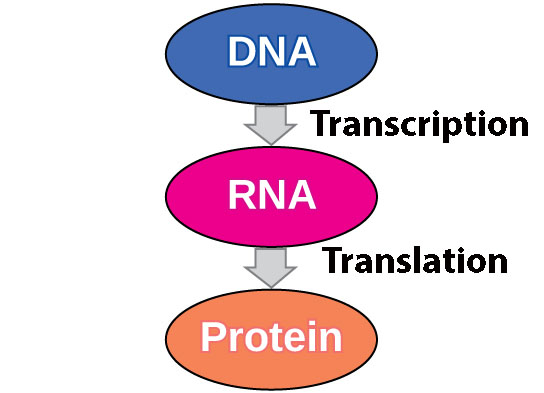
The Central Dogma of Molecular Biology states: DNA makes RNA makes protein.
This apparently simple statement contains a lot of information that we need to sort through.
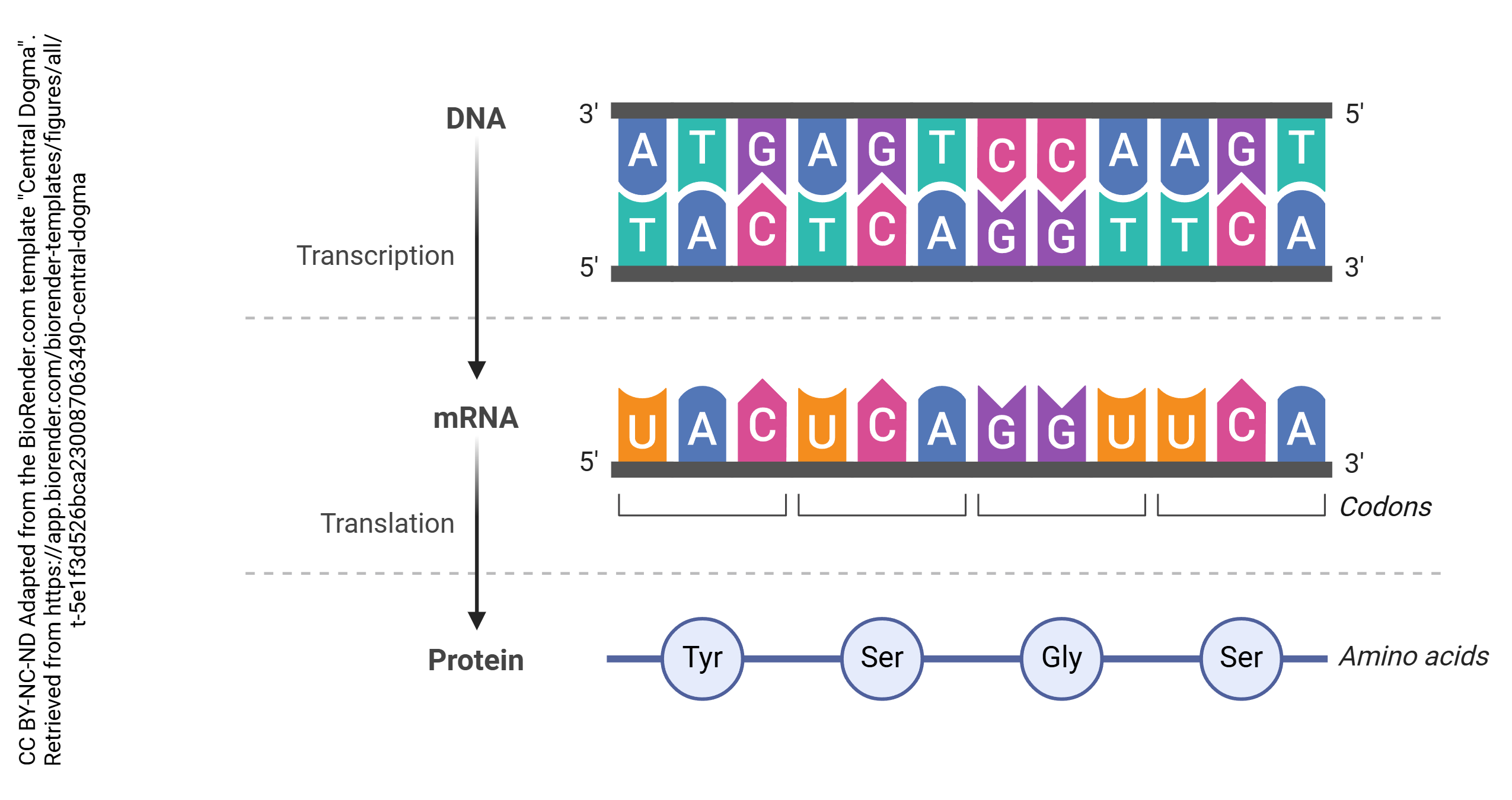
The process by which DNA makes RNA is called transcription. The basic structure of DNA and RNA are the same, so it’s just like transcribing a radio program into a written record: copying from one form to another in the same language.
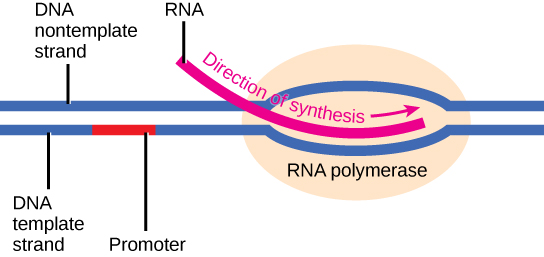
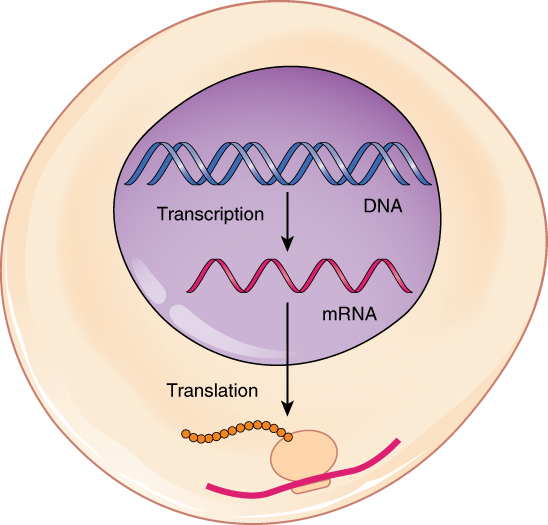
For a long time, scientists were baffled by viruses which contained RNA as their genetic material. It was obvious that they replicated themselves but, according to the first half of the Central Dogma (DNA and RNA…), without a DNA template imagine how this was done.
Discovery of the enzyme reverse transcriptase explained this phenomenon. Reverse transcriptase uses RNA as a template to make DNA. This process is called reverse transcription, because (surprise!) it’s the reverse of the transcription process.
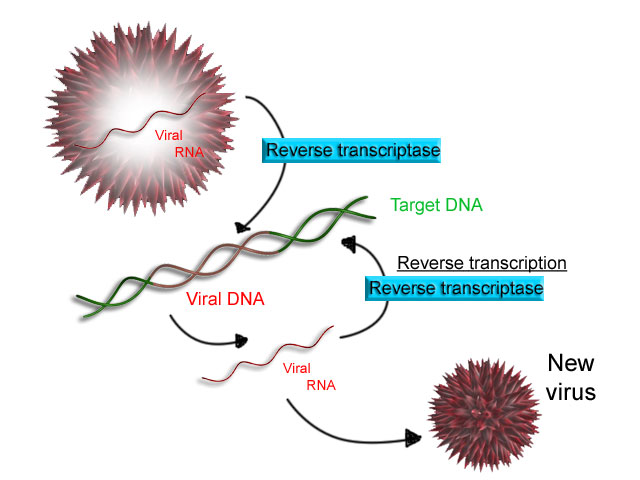
The viruses that have RNA as their nucleic acid are called RNA viruses. That should not be a surprise. There are also DNA viruses that have DNA at their core. Because viruses are technically not living, they must use the machinery of the host cell to replicate. Let’s diverge momentarily and look at how a virus invades a host cell and uses its machinery to make baby viruses.
An RNA virus (influenza shown here) attaches to a host cell. It gains access to the host cell by first binding to the cell; then it enters by endocytosis. In this way the host cell acquires the viral genetic material (RNA) and a viral RNA polymerase. The host cell’s ribosomes are then used to make any proteins the virus needs to spread the infection. The virus coats these materials in a piece of the host cell’s membrane. This host cell membrane cloak both helps it avoid detection by the host immune system and promotes attachment to a new host cell. The newly-formed viral particle leaves the host cell by exocytosis. And the cycle repeats.
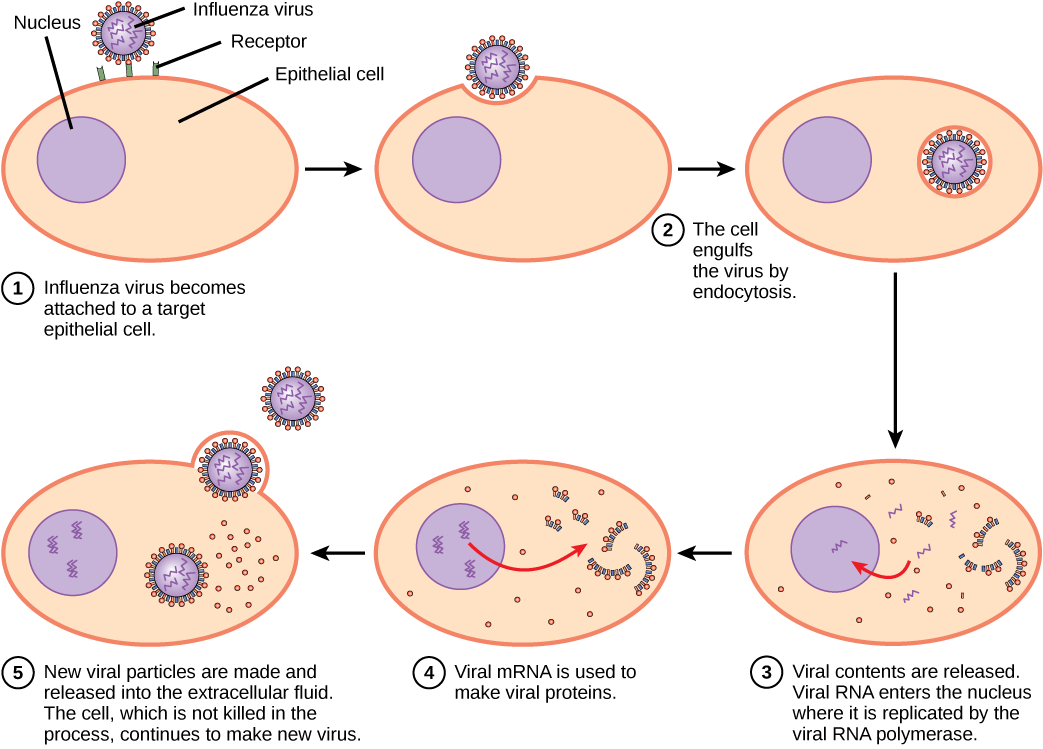
SARS-CoV-2*, the virus that causes COVID-19, is an RNA virus. These viruses are not as stable as DNA viruses and tend to mutate frequently, making it difficult to manufacture an effective vaccine. This is the reason we have a new flu vaccine every year. The Pfizer-BioNTech and Moderna COVID-19 vaccines are both a new type that uses messenger RNA (mRNA) to “teach” our immune cells to make a small piece of the viral antigen, which then causes an immune response in the recipient (more about this next semester in Unit 15). The beauty of this vaccine is the ability to code for a piece of the viral antigen that is not prone to mutation. In theory this vaccine should continue to be effective at targeting the virus, even if it the virus mutates.
*The name of the virus is Severe Acute Respiratory Syndrome coronavirus 2 (SARS-CoV-2) and the name of the illness it causes is coronavirus disease 2019 (COVID-19).
Another type of RNA virus is called a retrovirus. Human immunodeficiency virus (HIV), which causes the disease acquired immune deficiency syndrome (AIDS), adopts a similar strategy. It specifically infects cells we’ll learn about in Unit 15, called T helper cells, that direct the body’s immune response. Once it gains entry via the CD4 receptor on the surface of the T helper cell, it releases:
- the RNA genome which is copied by the host cell;
- reverse transcriptase, which makes the RNA into DNA; and
- an enzyme called integrase which integrates the viral DNA copy into the host cell DNA.
Changing the structure of DNA increases the probability of cancer, which is one of the things that makes retroviruses so evil. In the case of HIV, we now use a three-pronged therapy: a drug which blocks binding to the CD4 receptor; a drug which blocks reverse transcriptase; and a drug which blocks integrase. This so-called combination therapy has been quite successful in achieving remission of the worst effects of HIV infection.
Returning to the Central Dogma, the second step is conversion of RNA to protein, or translation.
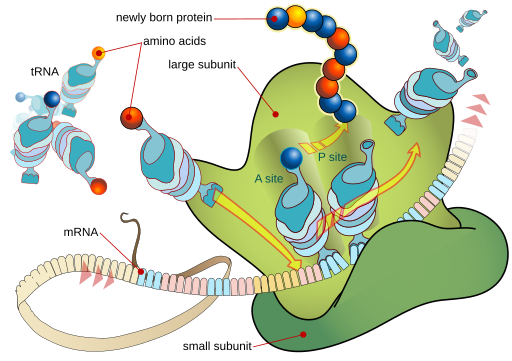
The process of translation is the conversion of an RNA code to protein. While RNA is a single-stranded nucleic acid with the bases A, C, G and U carrying the genetic code, proteins have 20 amino acids and a primary, secondary, tertiary and quaternary structure that is completely different from the structure of RNA. It’s appropriate that we call this translation, because we’re converting information from one “language” to another.
The macromolecular machine called the ribosome has parts made of ribosomal RNA (rRNA) and protein, and is the mechanism that converts the code contained in another type of RNA, messenger RNA (mRNA) into a primary protein sequence. In order to do this, we need amino acids that are delivered by a third type of RNA called transfer RNA (tRNA). Here, we can see the essential truth of the second part of the Central Dogma: RNA makes protein.
Media Attributions
- central dogma © Hutchins, Jim and Squidonius is licensed under a CC BY-SA (Attribution ShareAlike) license
- U06-16a Central dogma modified © Fowler, Samantha; Roush, Rebecca; Wise, James is licensed under a CC BY (Attribution) license
- U06-016 Central Dogma © Samara Ona adapted by Elizabeth Rebarchik is licensed under a CC BY-NC-ND (Attribution NonCommercial NoDerivatives) license
- U06-017 transcription © Fowler, Samantha; Roush, Rebecca; Wise, James is licensed under a CC BY (Attribution) license
- OpenStax Central Dogma © Betts, J. Gordon; Young, Kelly A.; Wise, James A.; Johnson, Eddie; Poe, Brandon; Kruse, Dean H. Korol, Oksana; Johnson, Jody E.; Womble, Mark & DeSaix, Peter is licensed under a CC BY (Attribution) license
- U06-018 RetroTranscription © Cyberugo is licensed under a Public Domain license
- U06-019 flu reverse transcription © https://openstax.org/details/books/biology-2e is licensed under a CC BY (Attribution) license
- Ribosome_mRNA_translation_en.svg © LadyofHats is licensed under a Public Domain license

